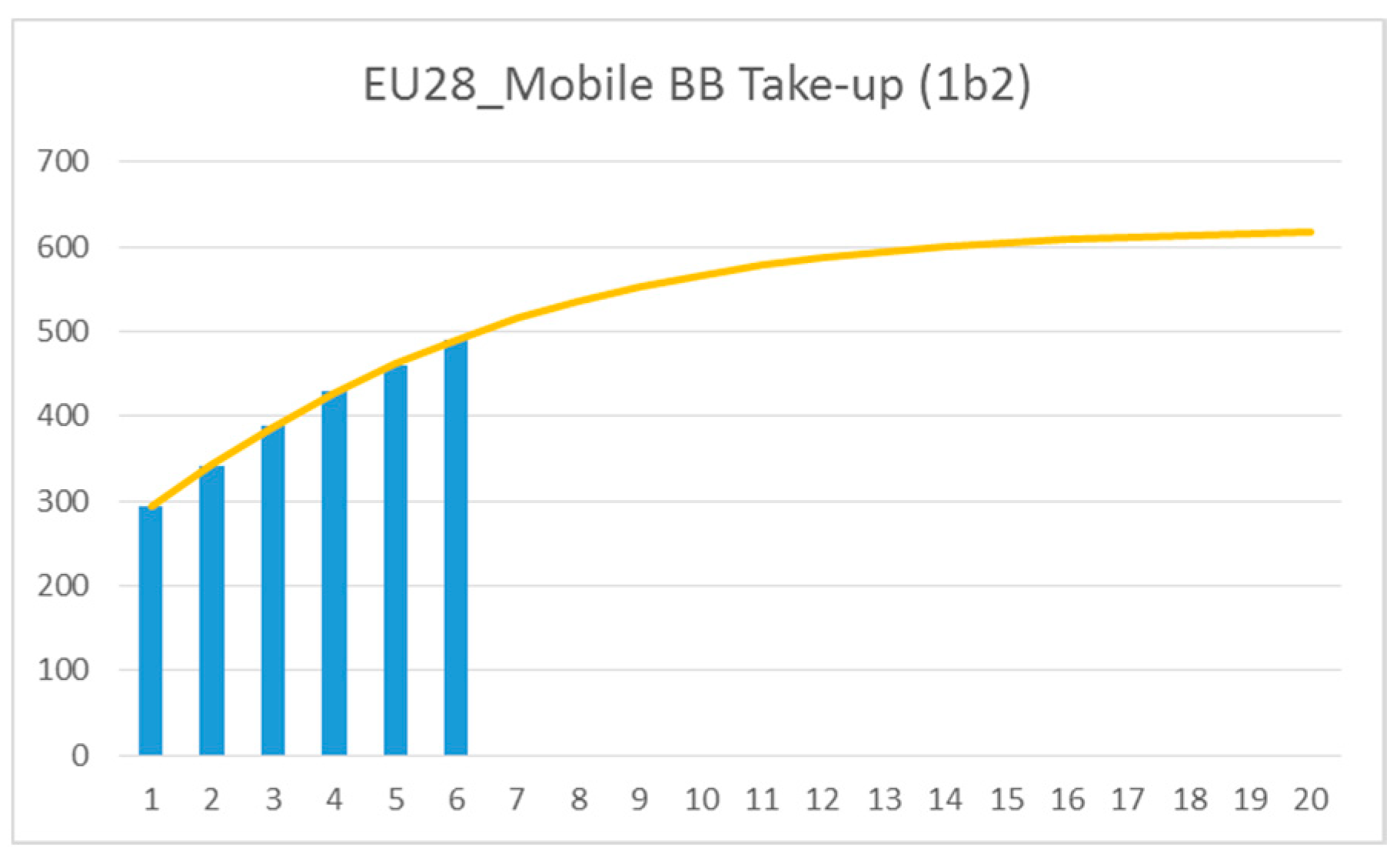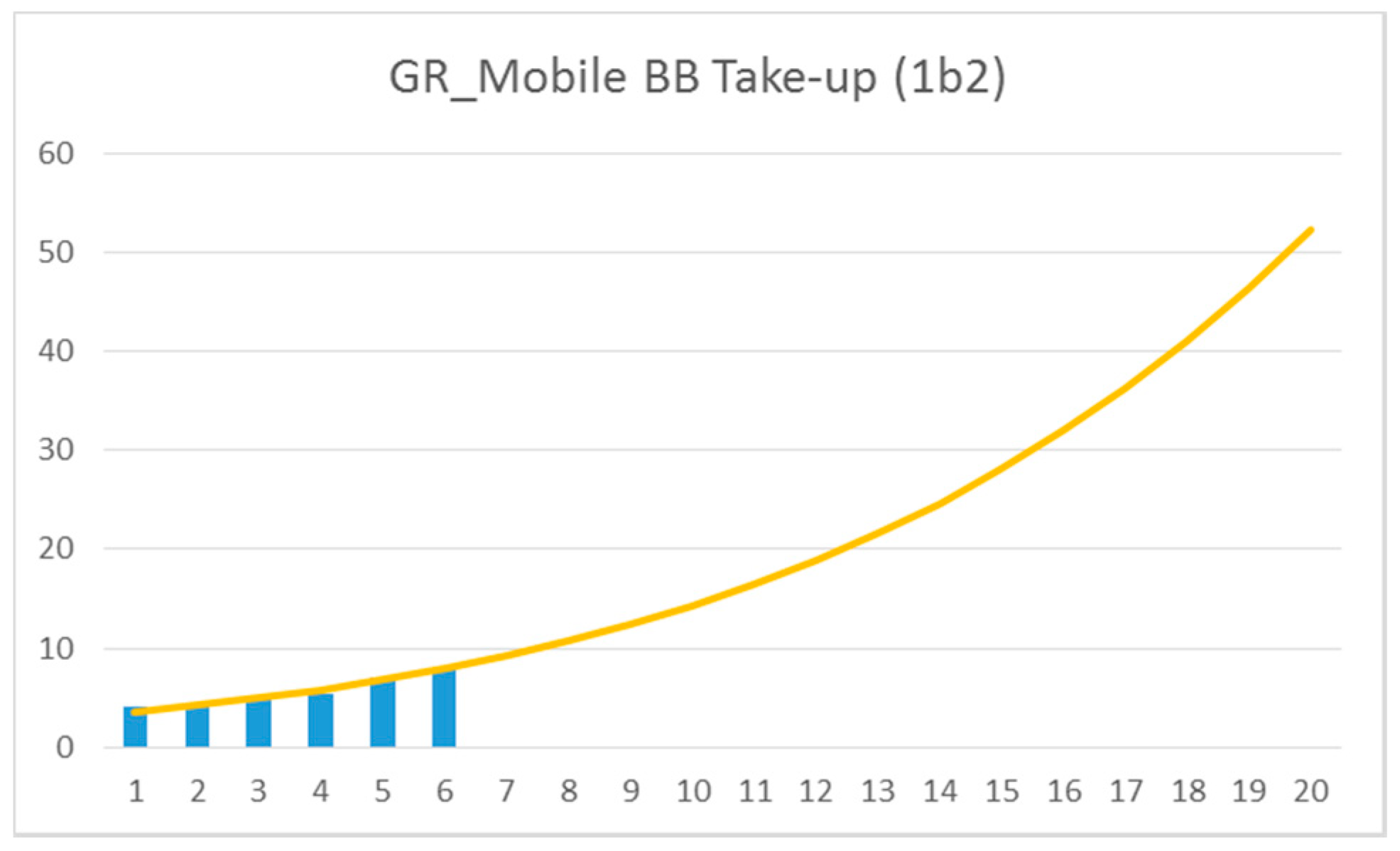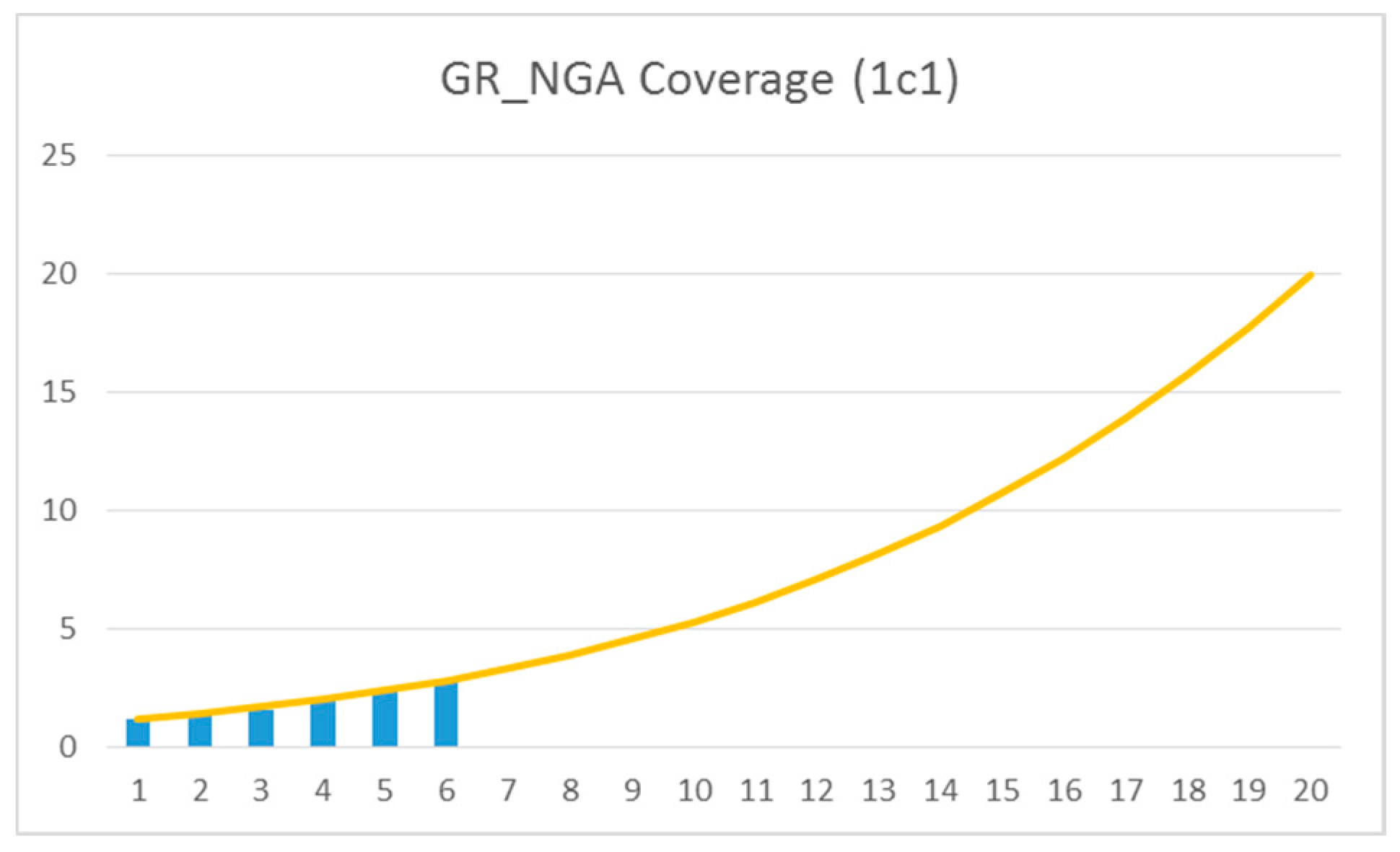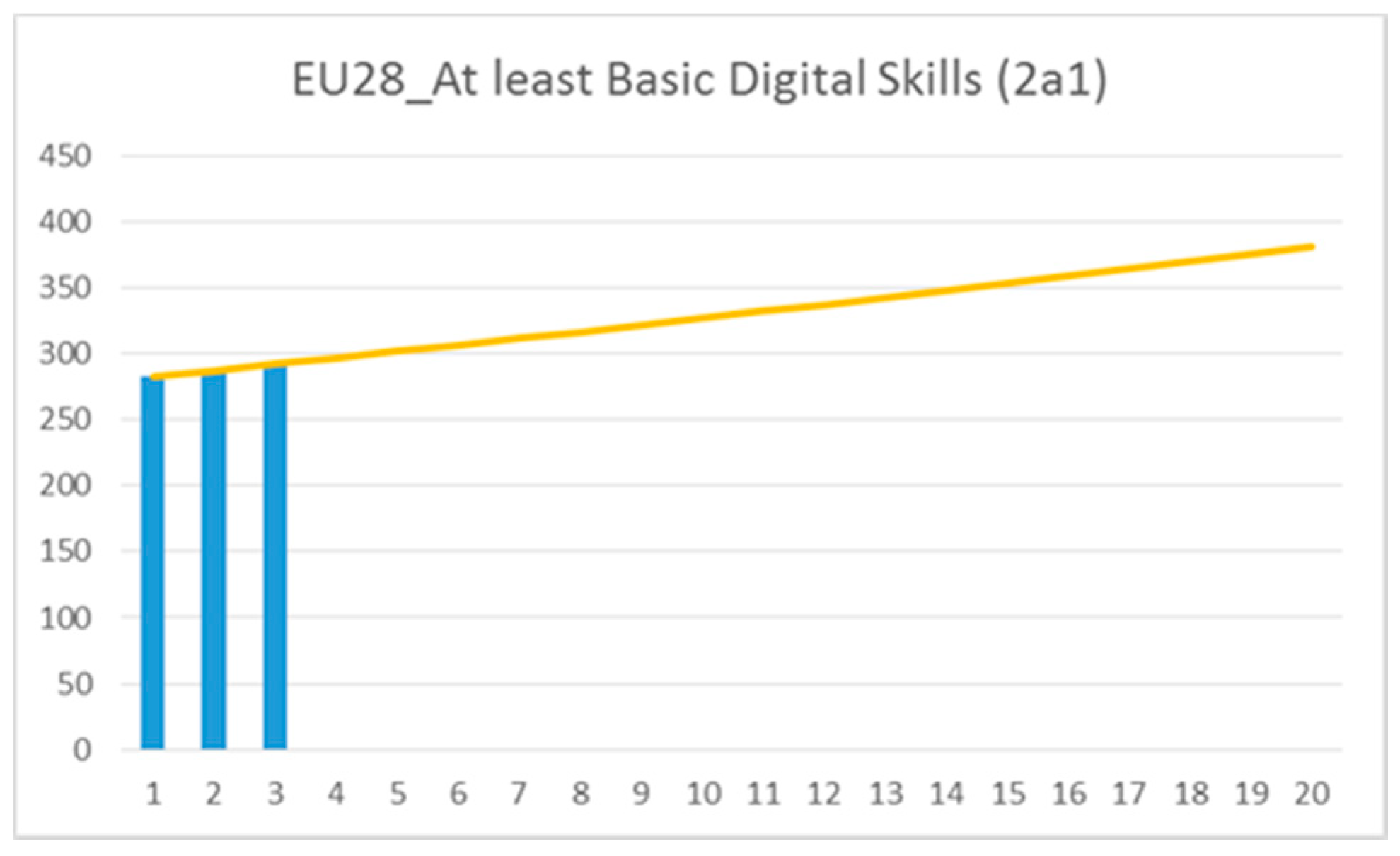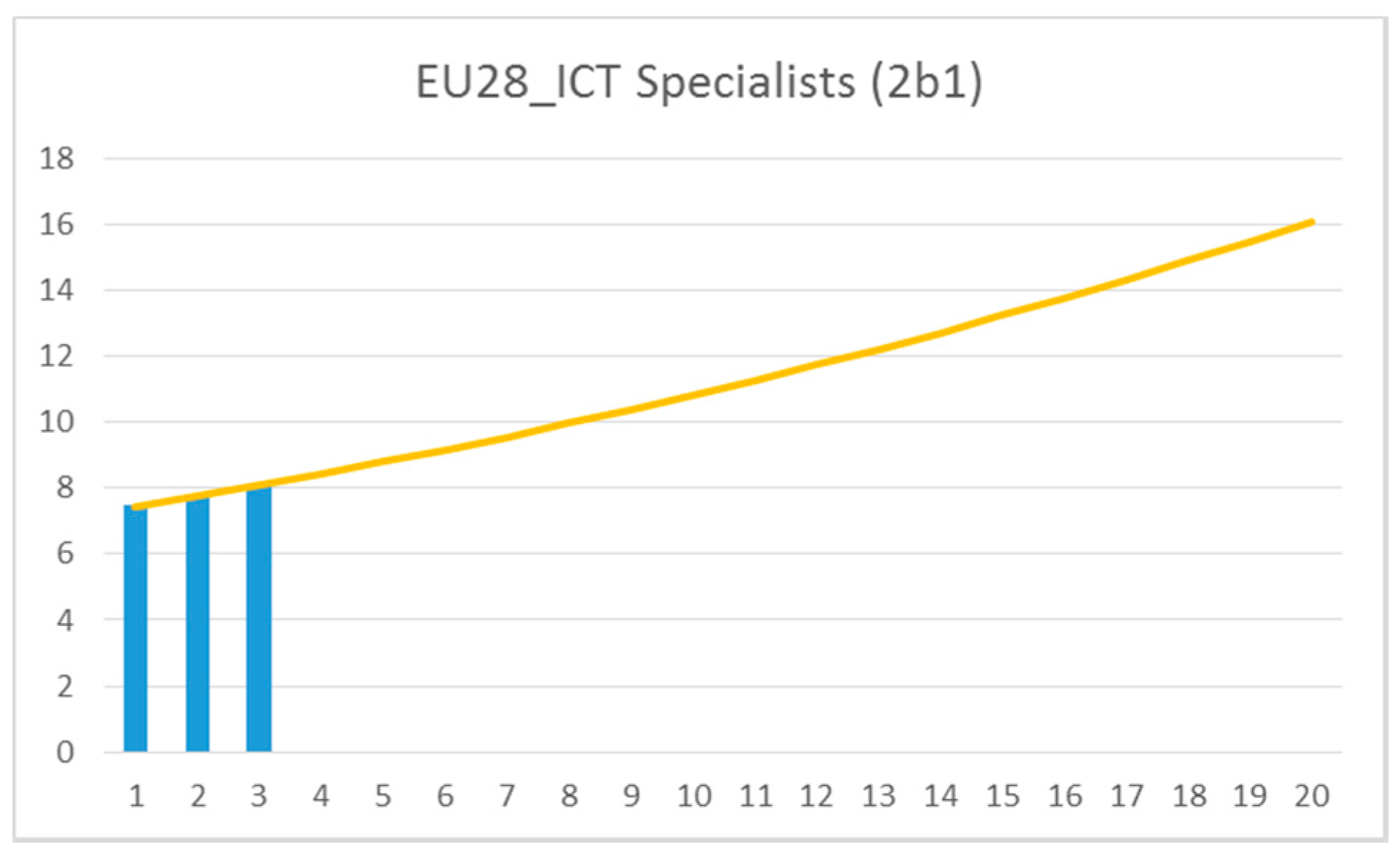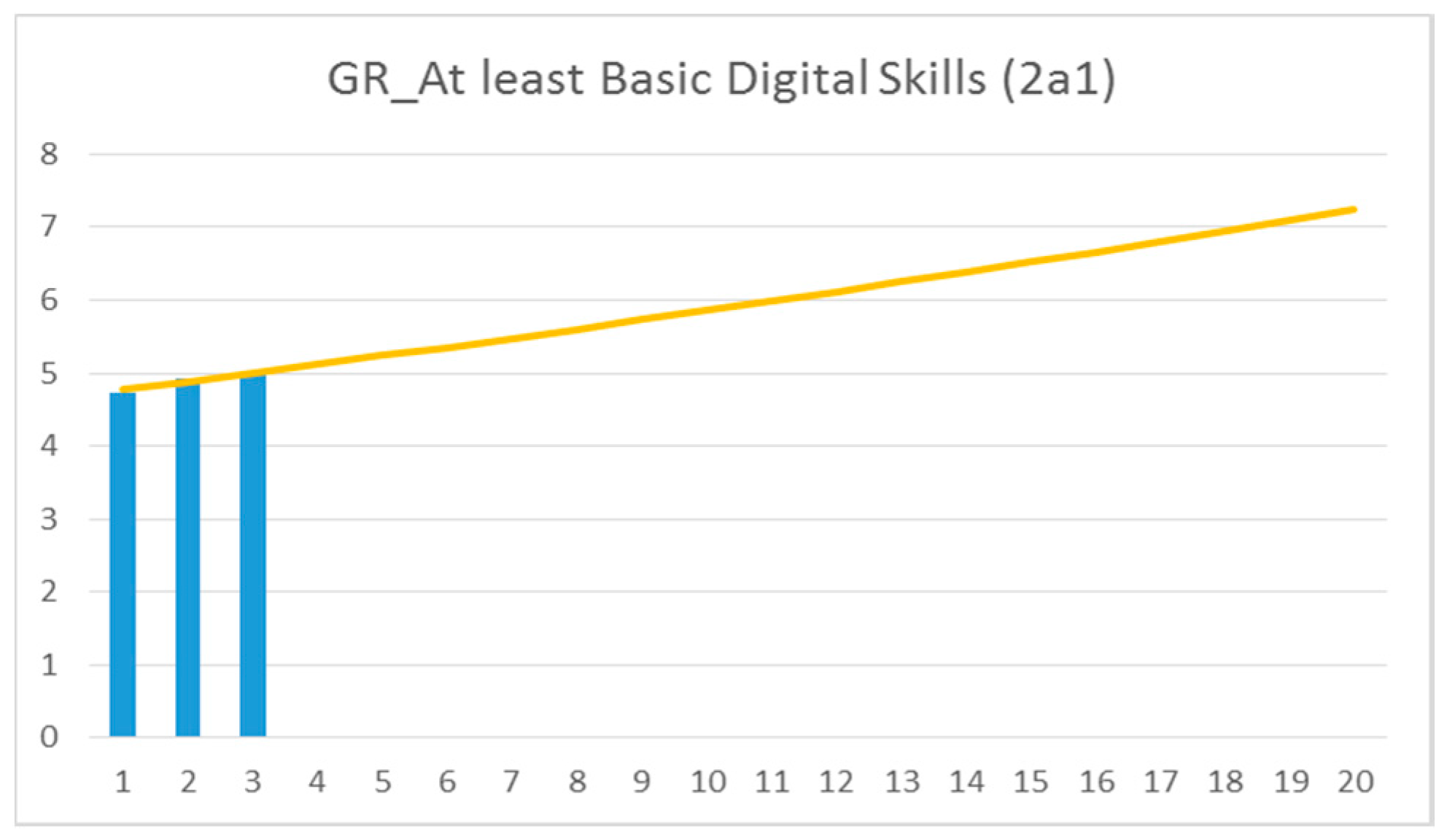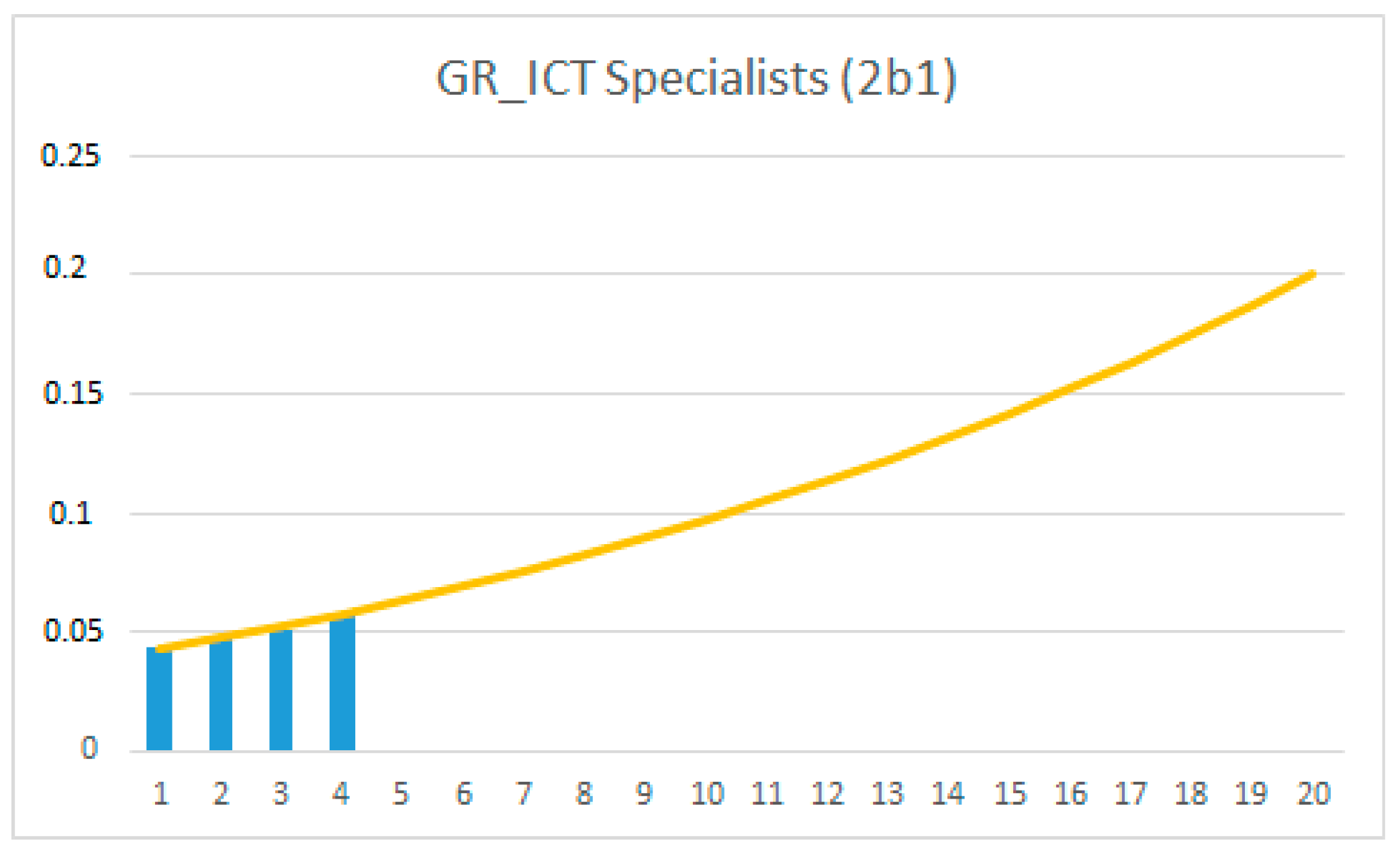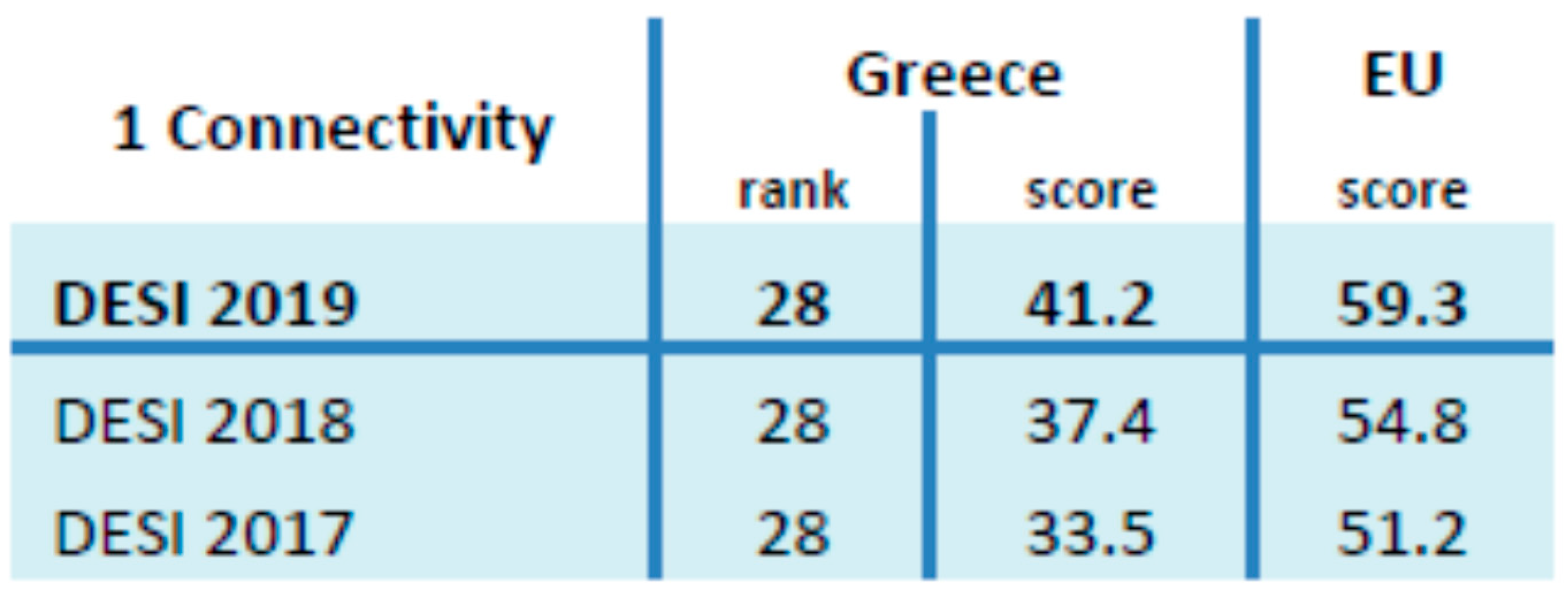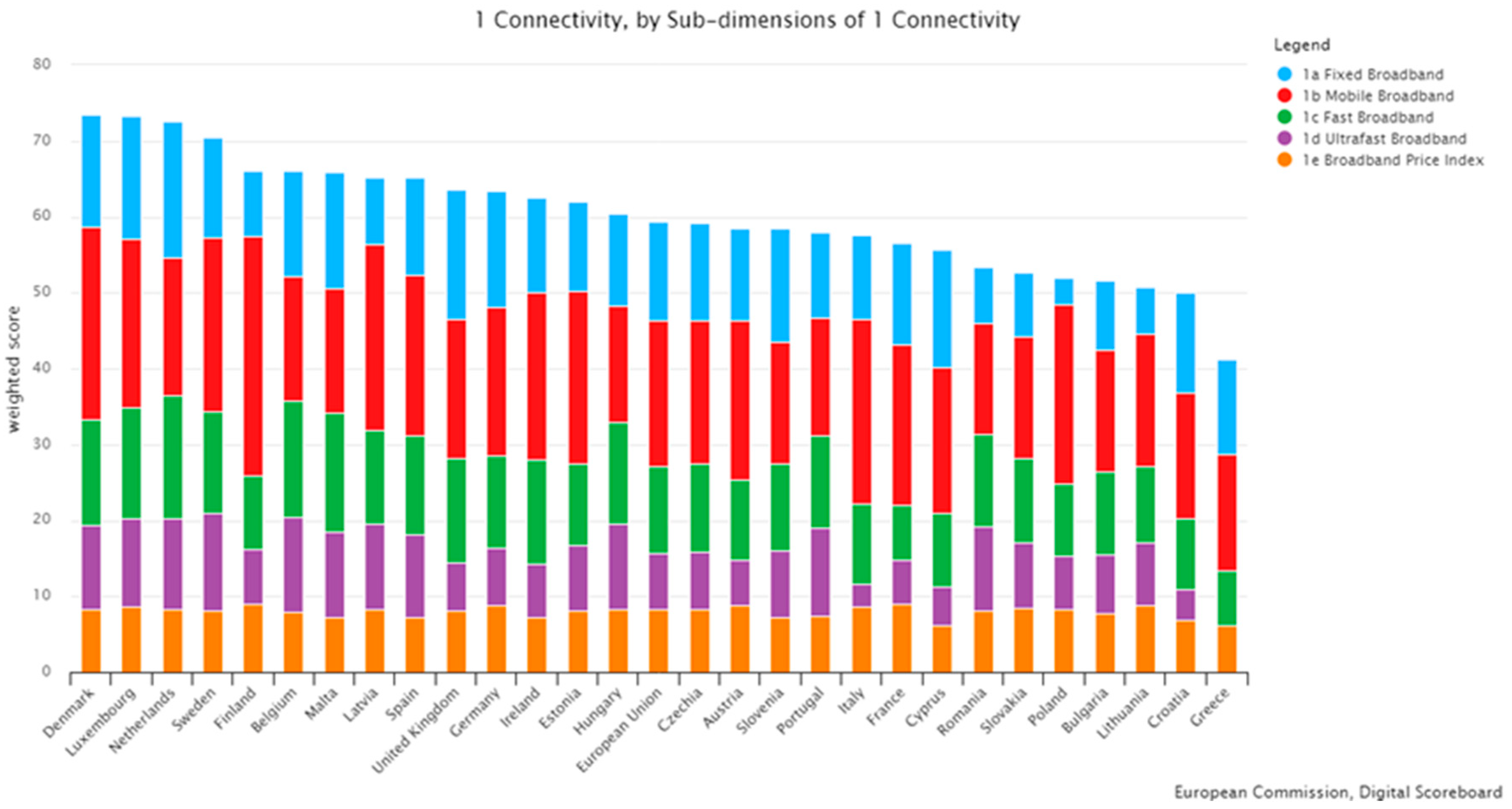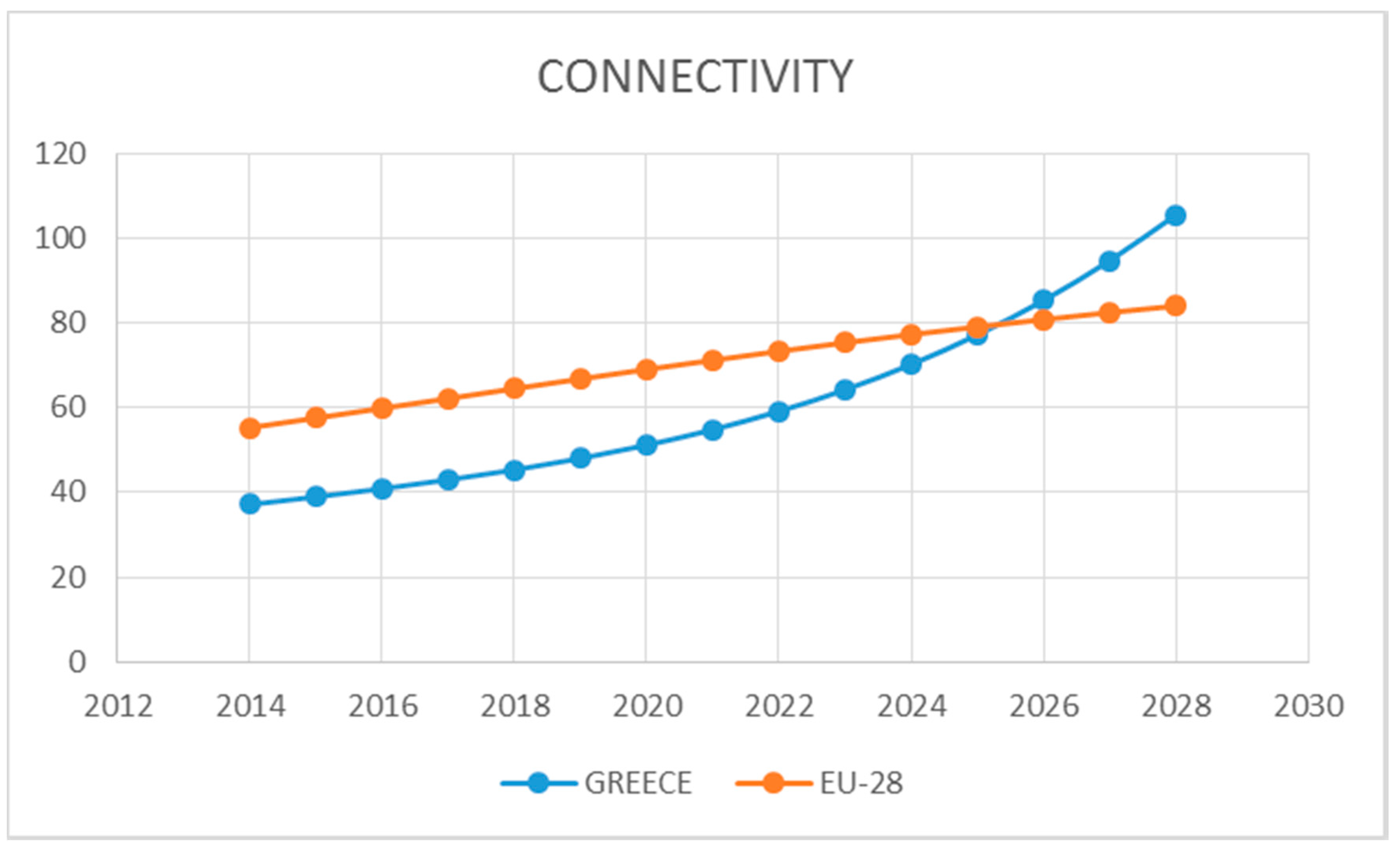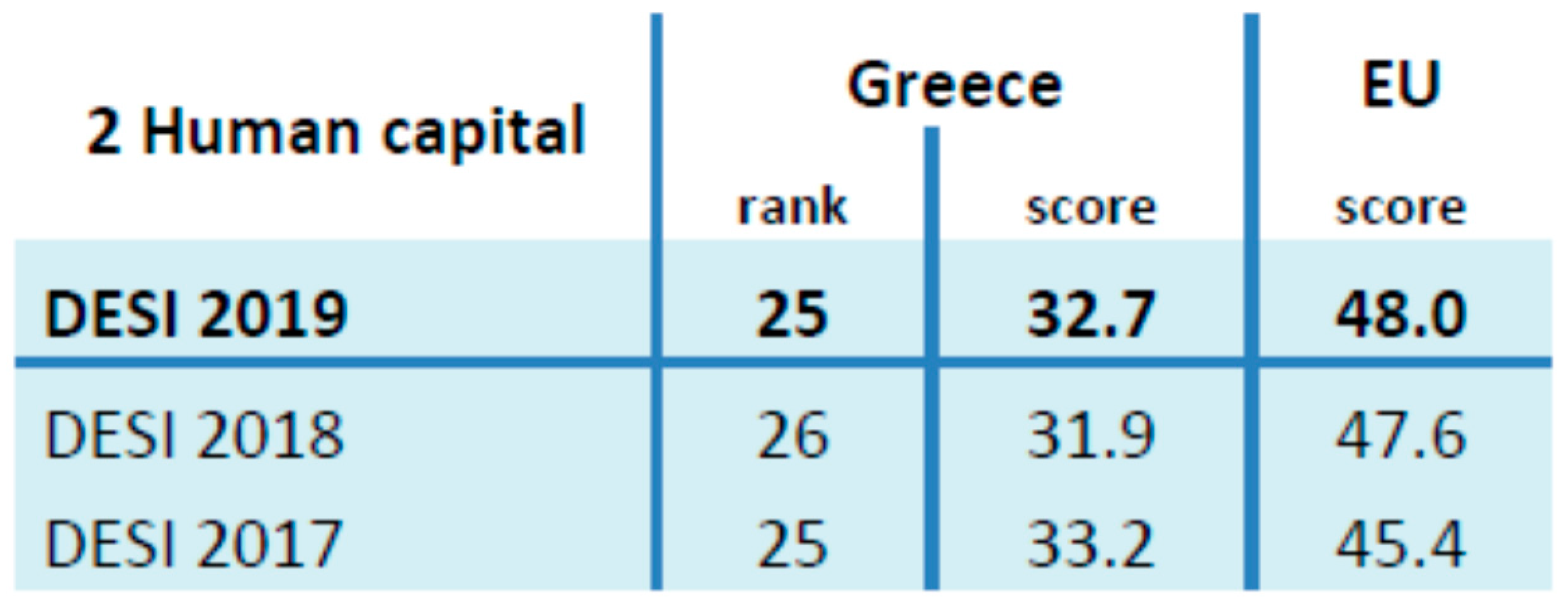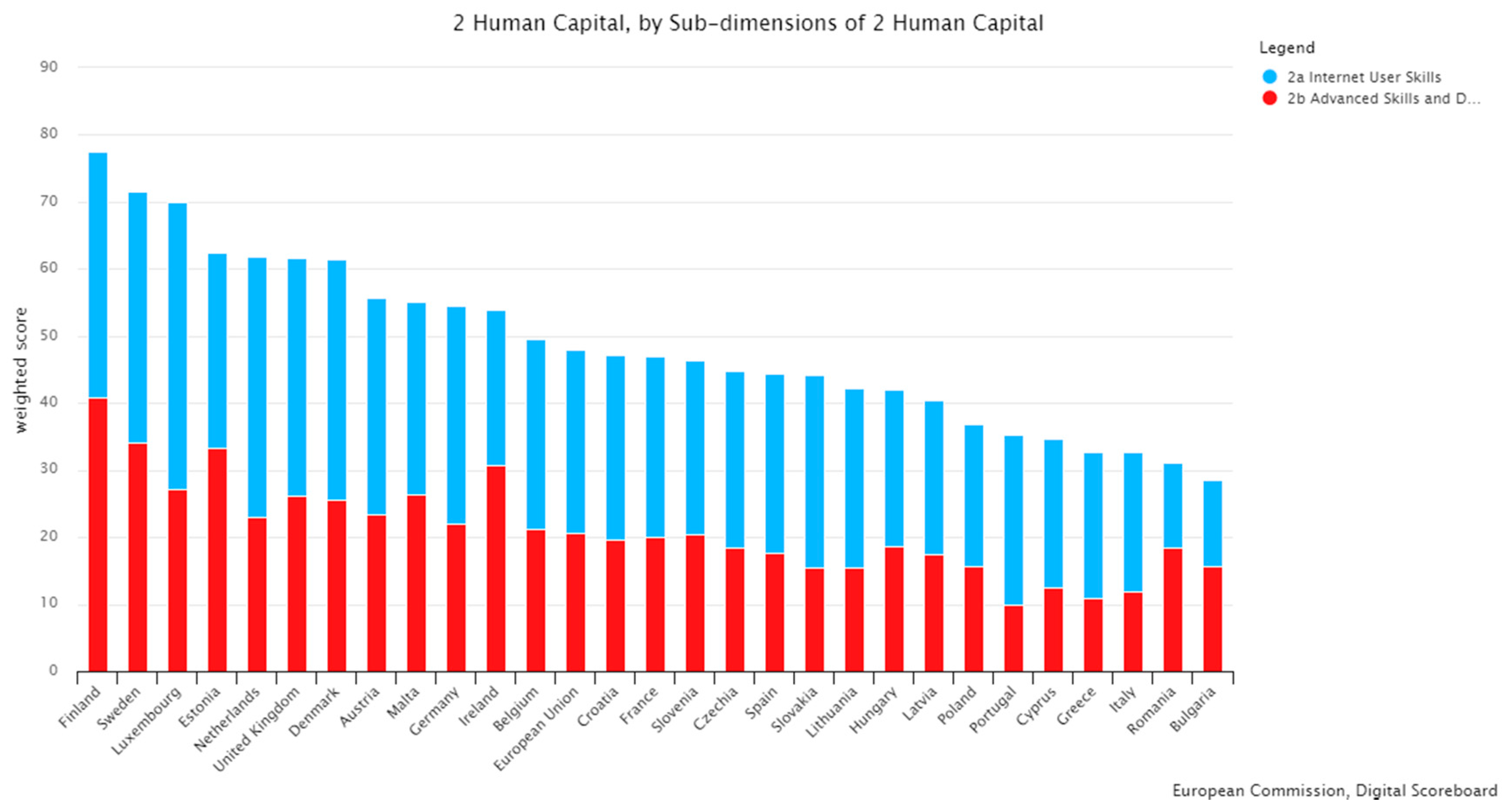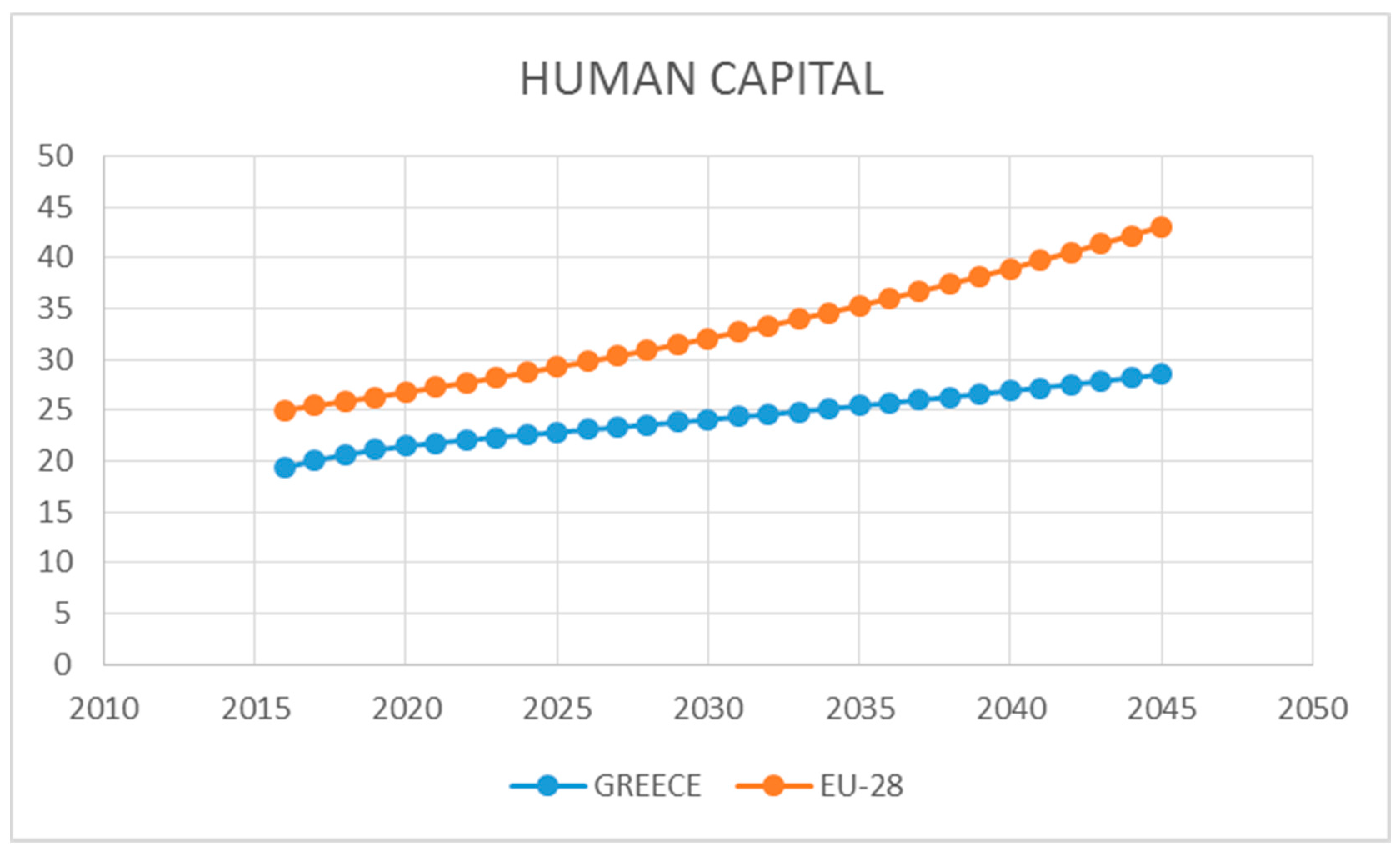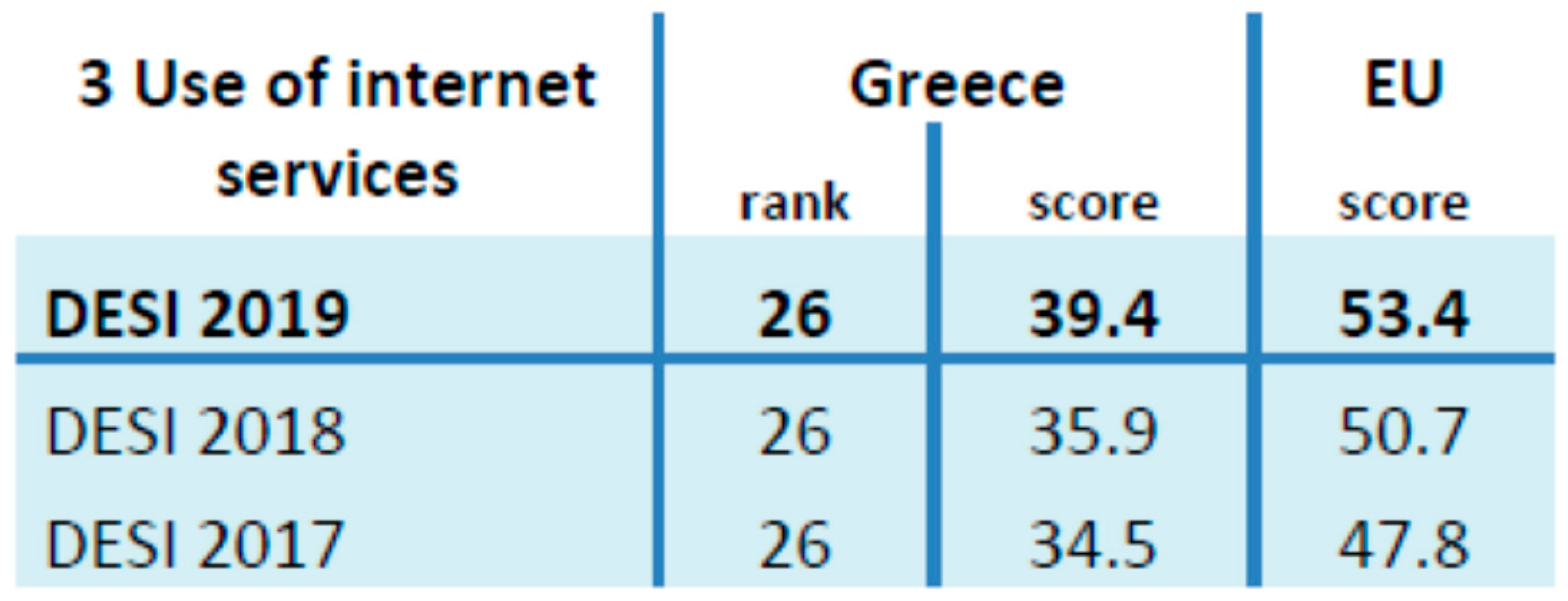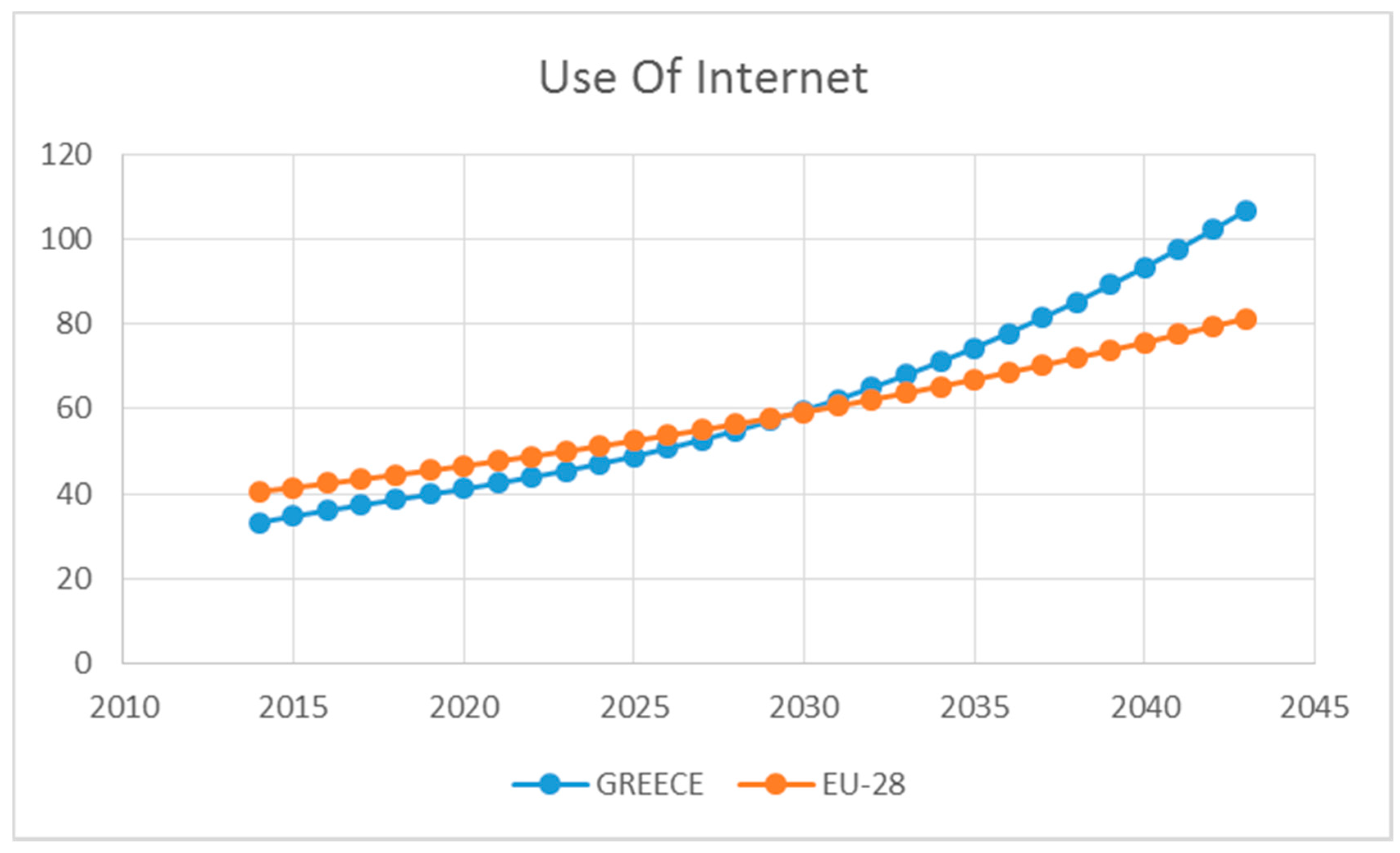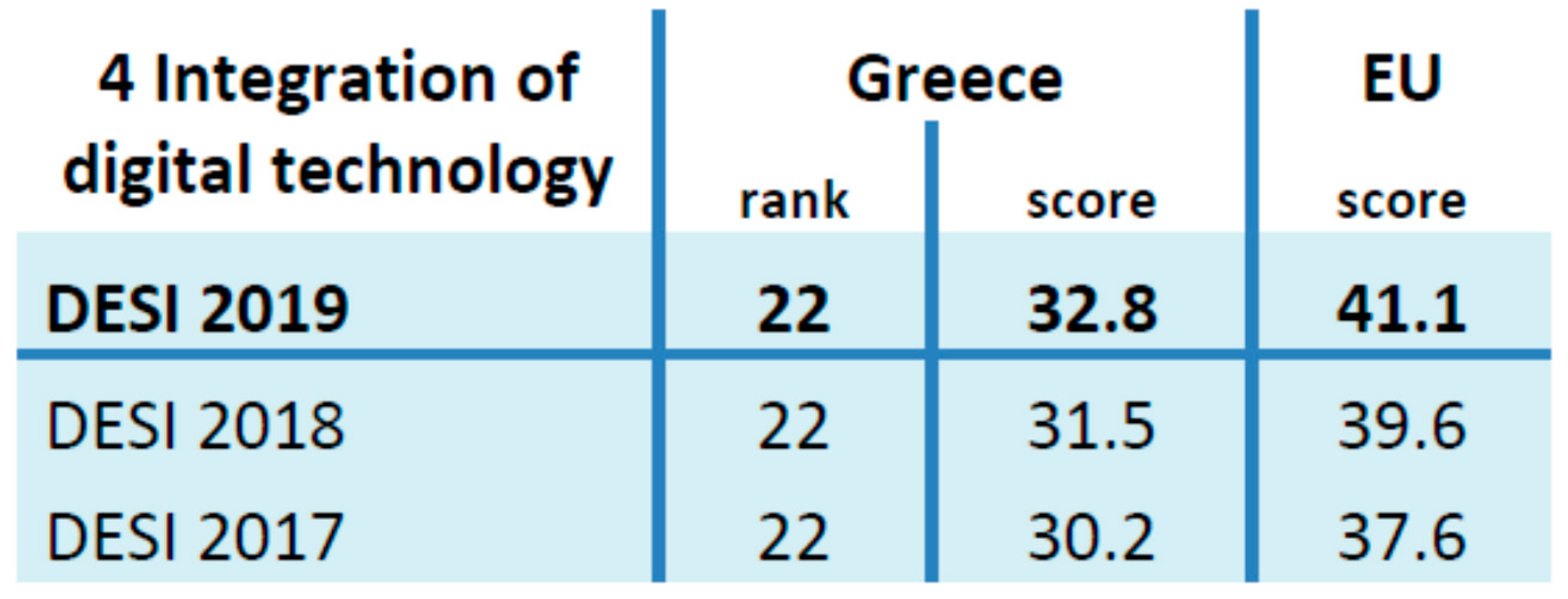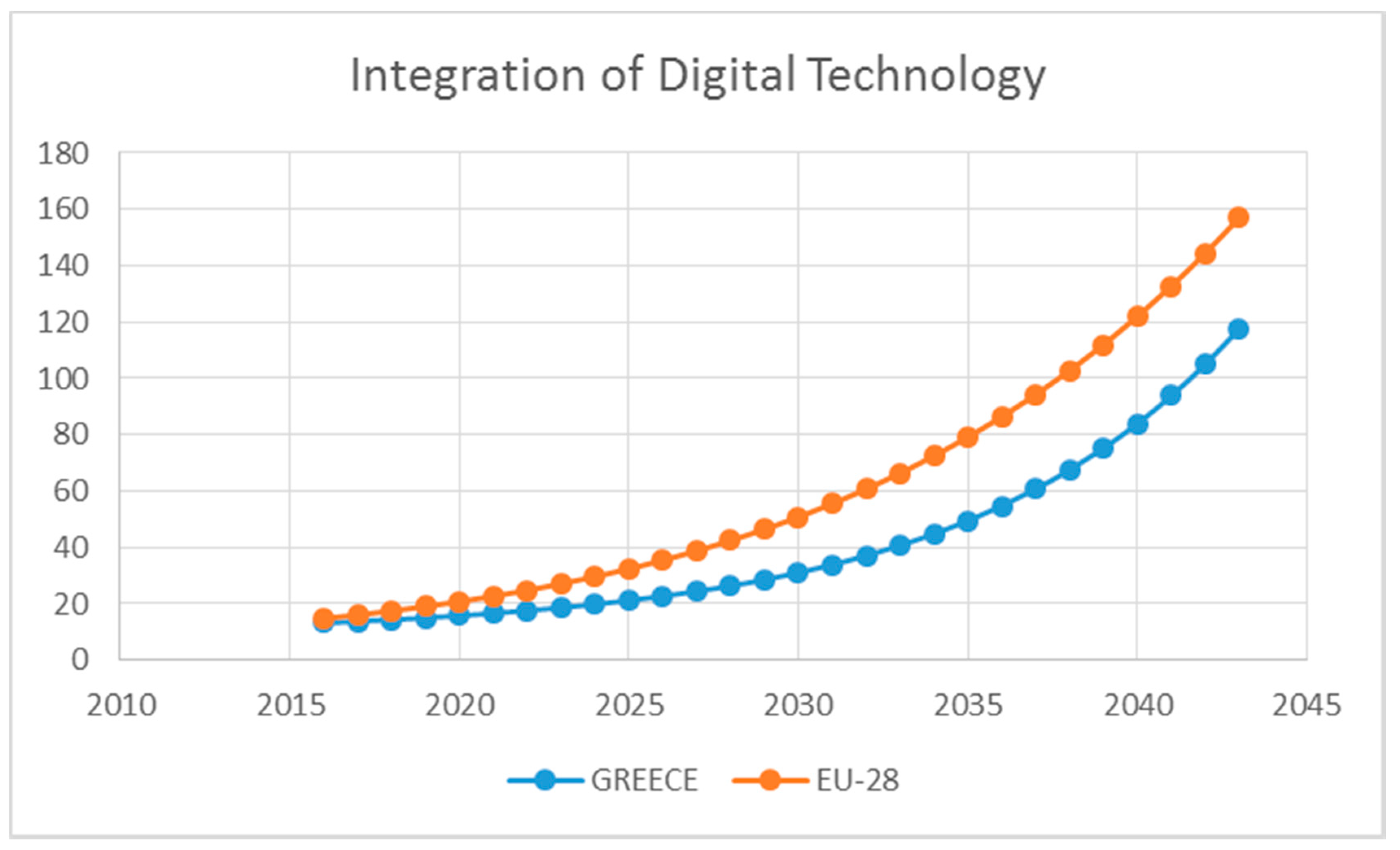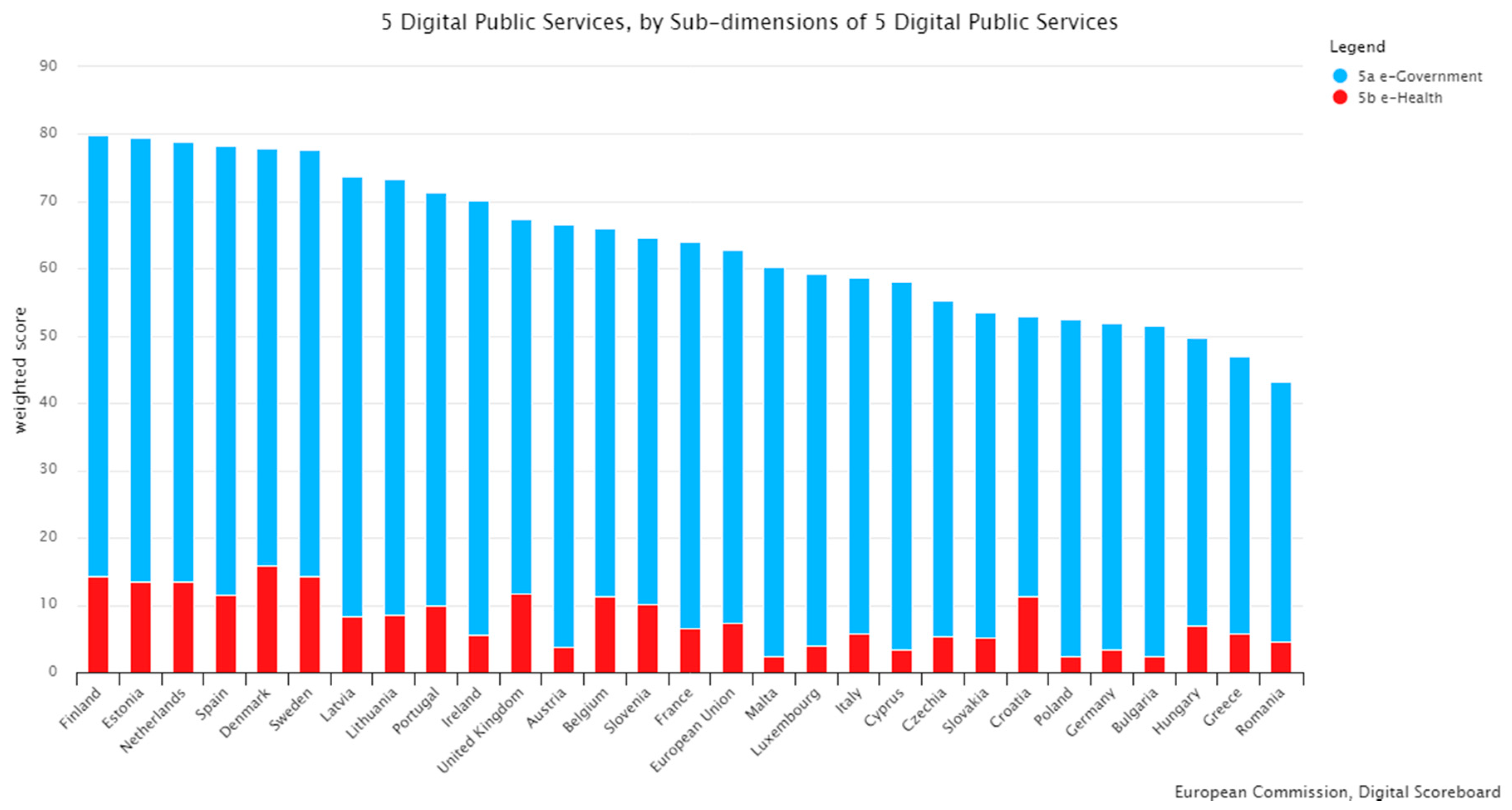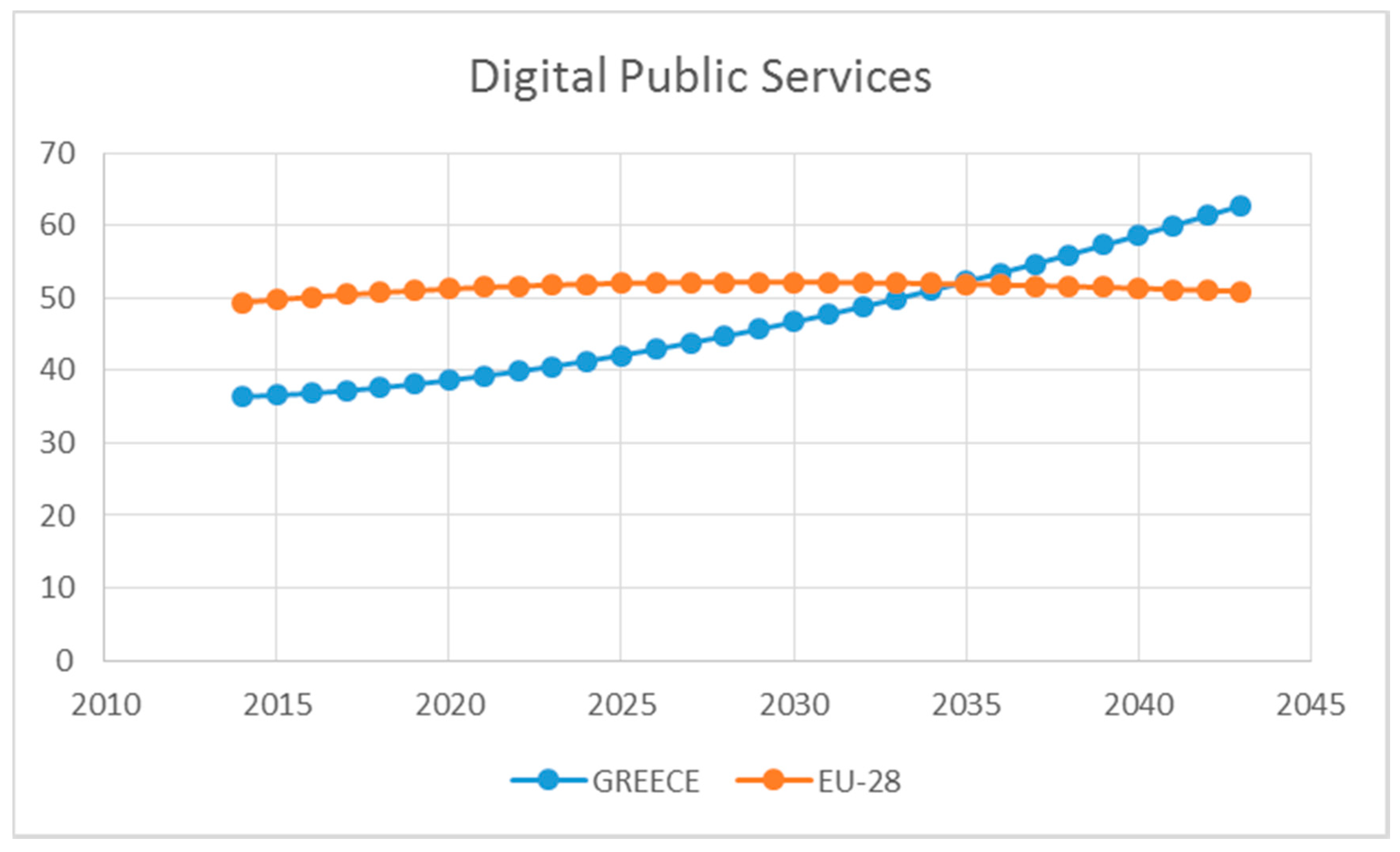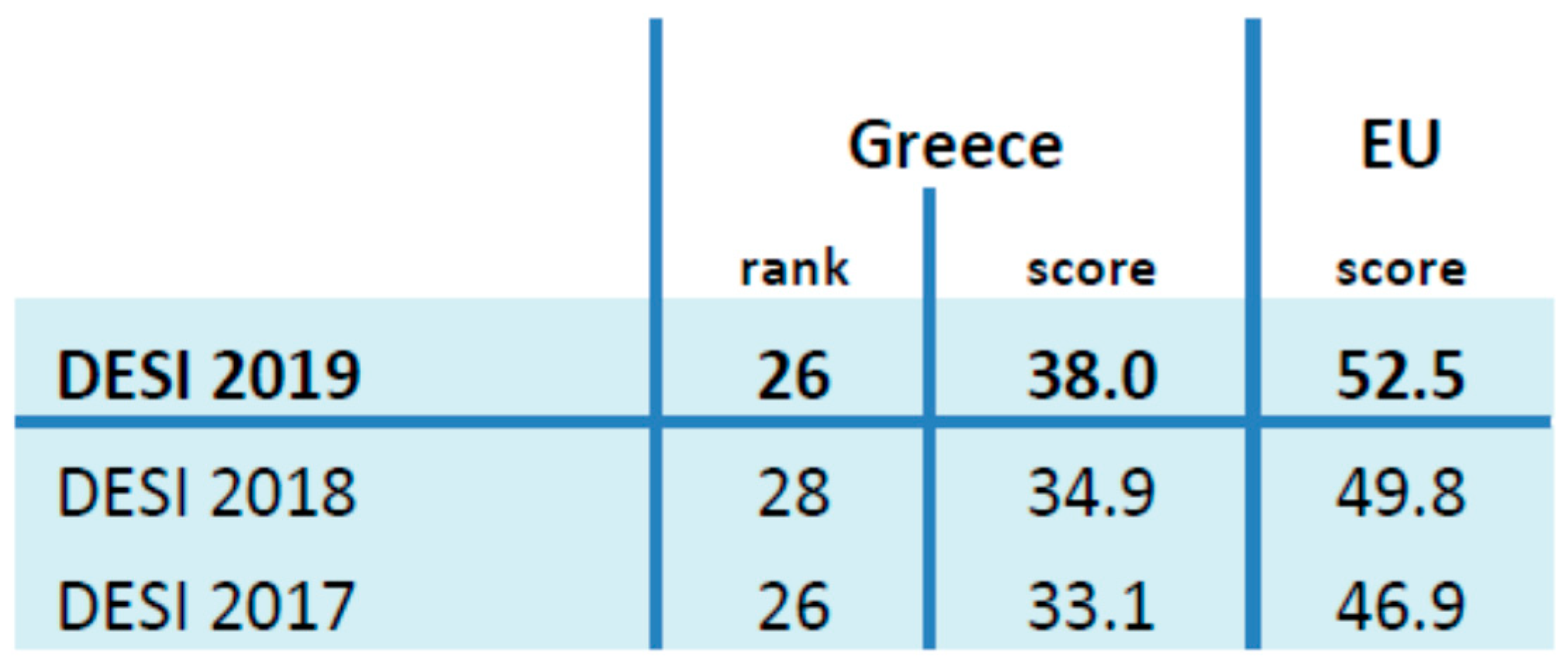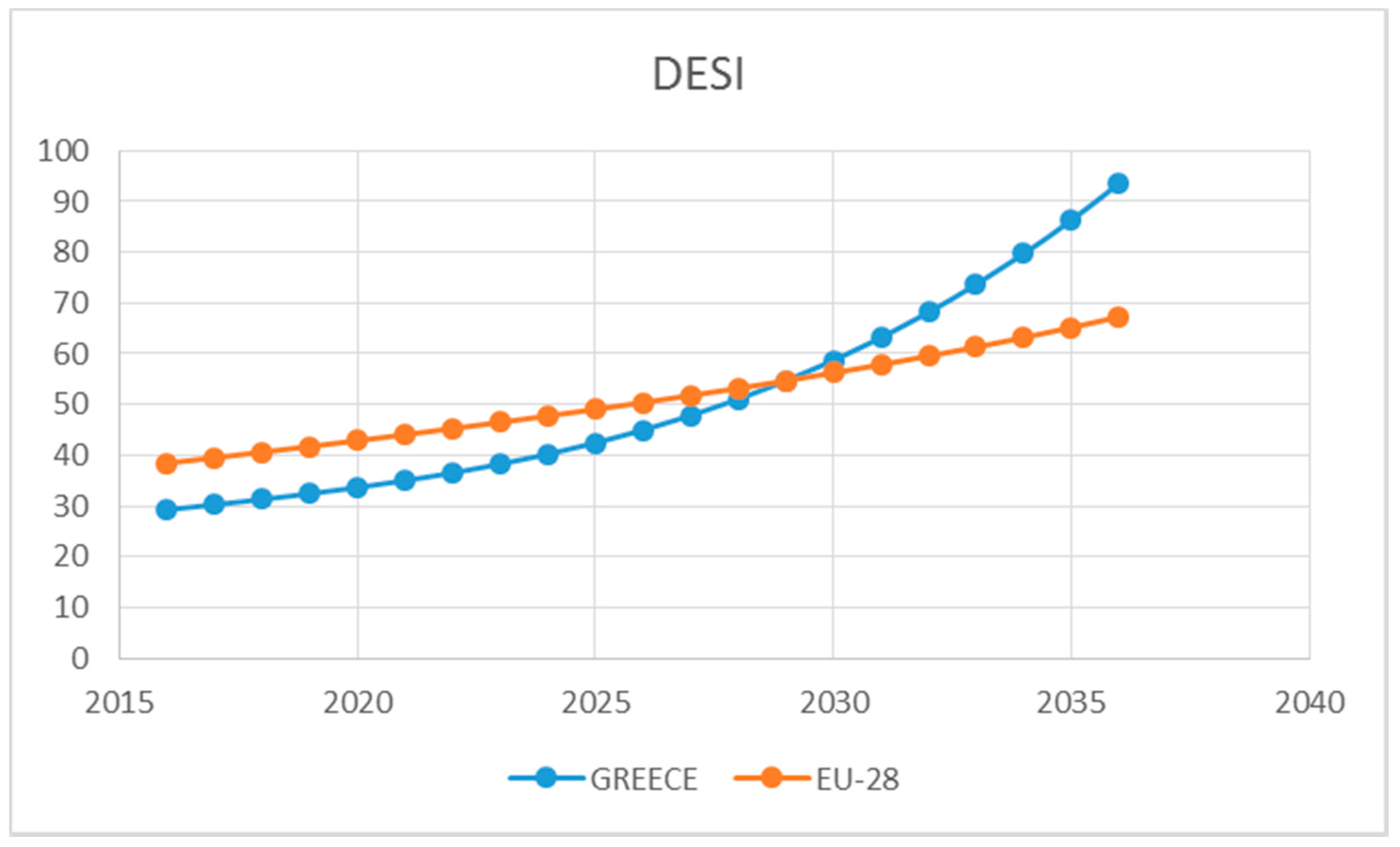The current section presents the results of the forecasting values for each of the five DESI dimensions and for the DESI index as a whole.
4.1. Connectivity
The Connectivity dimension measures the deployment of broadband infrastructure and its quality, as a necessary condition for competitiveness. Greece has systematically been found among the last ranks of EU-28 member states. Even though the Connectivity’s score has increased since 2017, no improvement has occurred as far as its rank is concerned, while the overall connectivity score is 41.2 for 2019 (
Figure 1). The country has a wide fixed broadband coverage, reaching 96%, which is slightly lower than the 97% EU-28 average (
Figure 2). Fixed broadband take-up is, however, progressing slowly (74%) compared with the rest of the EU member states. According to the European Commission (
European Commission 2019), this may reflect a comparatively high level of prices, compared to the EU-28, revealed by the indicator entitled “Broadband price index”, in which Greece is ranked last.
As far as 4G coverage is concerned, Greece has 92% coverage, slightly below the EU-28 average but the results indicate that mobile broadband take-up is estimated at 74 subscriptions per 100 people, well below the EU average of 96 subscriptions per 100 people. 5G readiness is estimated at 0%, which is a delay compared to the 14% of the rest of the member states. NGA coverage remains at low levels (66% compared to 83% for the rest of the EU), and even though there is an increase in subscriptions related to fast broadband networks, the national percentage (11%) is rather low compared with the European average (41%). Finally, with a percentage beneath 1%, it is as if the country has almost no ultrafast broadband networks.
Even though there is an update of the national broadband plan and significant progress of the vectoring implementation, there still exist important delays in implementing the projects and in the absorption of the funds allocated. This fact led the country to be ranked 28th among the EU-28 countries in 2018. Greece bases its hopes for further improvement on private investments that may be favored by changes to the existing legal framework, that can enhance investments in 5G development and hasten the proceedings for antenna permits.
Taking into consideration the progress and data values during the years 2014–2019, the forecasting techniques were applied for the values that can be forecasted for Greece and the EU-28 (gray rows in
Table 2). The values of the rest of the subdimensions remained constant (subdimension of Broadband Price Index).
Forecasted values were calculated for each indicator (with gray color), while each indicator contributes to a single subdimension (column entitled “Indicators Contribution). Each of the four DESI Connectivity subdimensions was calculated as the weighted average of the normalized indicators, while the fifth subdimension remained as a constant price. Finally, the DESI “Connectivity dimension” was calculated as the weighted average of the five subdimensions: (a) fixed broadband (18.5%), (b) mobile broadband (35%), (c) fast broadband (18.5%), (d) ultrafast broadband (18.5%) and (e) Broadband Price Index (9.5%).
The chart below (
Figure 3) graphically presents the DESI Connectivity dimension for Greece and the EU-28. The proposed methodology forecasts a converging procedure, while the results calculated estimate that Greece will exceed the EU-28 average, in 2026. As far as the Connectivity dimension is concerned, Greece seems to be in a take-up procedure, while the reasons for being below the EU-28 average seem to be known and under a find—solution procedure. Fast broadband and ultrafast broadband seem to be the subdimensions that need more action from a regulatory and the state’s scope.
4.2. Human Capital
The Human Capital dimension measures the skills needed to take advantage of the possibilities offered by digital. Even though Greece has made some progress, it still remains well below the EU-28 average. The country is not ranked last in the EU-28, positioning in 25th place (
Figure 4 and
Figure 5), since Italy, Romania and Bulgaria are lower in the ranking. It should be stressed that as far as the last two countries are concerned, they both have a higher degree in “Advanced Skills and Development” than Greece, which mainly reflects professionals’ and specialists’ skills. Greece’s main advantage is based on “Internet user skills” which reflect the wider society.
It is worth mentioning that during 2017, less than 50% of the individuals aged between 16 and 74 years old had at least basic digital skills (57% in the EU-28). Most significant is that 31% of those that did not have basic digital skills (almost 16% of the total population) reported having no digital skills at all. This is one of the main indicators where a great divergence exists between Greece and the EU-28, with the former’s percentage being 31% and the latter’s percentage being 17%.
Moreover, Greece seems to have the lowest share of ICT specialists in total employment in the EU-28: 1.6% in 2017, compared with an EU-28 average of 3.7%. The financial crisis has most probably forced the most experienced and well-educated employment force to emigrate to other European Union countries, as the ICT specialist sector is a much more promising sector for job seeking abroad for Greek professionals of the sector.
Taking into account the progress and data values during the years 2016–2018, the forecasting techniques were applied for the values that can be forecasted for Greece and the EU-28 (gray rows in
Table 3). The rest of the values regarding indicators (2a3—At least basic software skills, 2b2—Female ICT specialists, 2b3—ICT graduates) remain constant.
Forecasted values were calculated for each indicator (with gray color), while each indicator contributes to a single subdimension (column entitled “Indicators Contribution”). Each of the two DESI Human Capital subdimensions was calculated as the weighted average of the normalized indicators. Finally, the DESI “Human Capital dimension” was calculated as the weighted average of the two subdimensions: (a) Internet user skills (50%) and (b) Advanced skills and development (50%).
The chart (
Figure 6) shows graphically the DESI Human Capital dimensions for Greece and the EU-28. The calculations show that Greece is not converging on the other states, thus there is a necessity for Greece to implement a more effective strategy, in order to attain the EU-28 average. Most significantly, it must be reported that the results indicate that the rest of the EU-28 member states seem to invest more in human capital, especially as far as it concerns Advanced skills and development. Divergencies in this dimension may lead to a multi-speed European Union regarding skills and conditions for further business and societal development.
4.3. Use of Internet
The Use of Internet Services dimension accounts for a variety of online activities, such as the consumption of online content (videos, music, games, etc.) and video calls as well as online shopping and banking. These activities can be divided into two general categories: (a) activities conducted by individuals for entertainment and (b) activities conducted as part of a professional or business life.
Figure 7 reveals that Greece is ranked among the last positions in the EU-28.
Even though the number of internet users is growing, these users are mainly concentrated on online activities related to entertainment (e.g., news online, making video calls and using social networks). A total of 87% of Greek internet users read news online, 61% use video calls and 73% use social networks. On the other hand, more professional activities such as professional social networks, banking, shopping and selling online are far below the EU-28 average, revealing an existing digital gap. This gap is better revealed in
Figure 8, where Greece is ranked above Bulgaria and Romania only.
Taking into account the progress and data values during the years 2016–2018, the forecasting techniques were applied for the values that can be forecasted for Greece and the EU-28 (gray rows in
Table 4). The rest of the values regarding indicators (3a1—People who never used the internet, 3b2—Music, videos and games, 3b3—Video on demand, 3b7—Doing an online course, 3b8—Online consultations and voting, 3c3—Selling online) remain constant.
Forecasted values were calculated for each indicator (with gray color), while each indicator contributes to a single subdimension (column entitled “Indicators Contribution”). Each of the three DESI Use of Internet subdimensions was calculated as the weighted average of the normalized indicators. Finally, the DESI “Use of Internet dimension” was calculated as the weighted average of the three subdimensions: (a) Internet use (25%), (b) Activities online (50%) and (c) Transactions (25%).
The timeline chart (
Figure 9) depicts the DESI Use of Internet dimension for Greece and the EU-28. The calculations show that Greece is converging on and will exceed the EU-28 average in 2030. It is the second dimension, after the Connectivity dimension, where a convergence is forecasted.
In this case, the forecast reveals a convergence in 2030, while the Connectivity dimension had a timeline of convergence around 2026. This delay can be explained as a result of the small penetration of online services and use of internet in general for business and professional purposes. Motives could create a demand boost, leading to a faster convergence degree. At the current point, coming closer to the EU-28 average is mainly a result of the use of the internet for entertainment, news and social networks.
4.4. Integration of Digital Technology
The Integration of Digital Technology dimension measures the digitization of businesses and e-commerce. This dimension is mainly addressed for businesses, proposing that the adoption of digital technologies can enhance efficiency and reduce costs. Moreover, digital technologies are one of the most important means to engage customers with brands and businesses, while sales via the internet can expand businesses’ boundaries to the global markets.
Greece is ranked 22nd among the EU-28 (
Figure 10), which is the best rank among all five DESI dimensions. Regardless of this rank, its score is well below the European average, while the total rank remains the same for the last three years. The progress achieved can be characterized as marginal and that explains the reason why the rank is unchanged.
Electronic information sharing, social media and big data are the three indicators where Greece is near or above the EU-28 average. On the other hand, significant delays exist in terms of cloud computing, where the national scores are that only 11% of Greek SMEs sell online and 7% sell online cross-border, while at the same time, the European average is 17% and 8%, respectively.
Even though the country is not ranked among the last few EU member states, the scores achieved should trouble decision makers. The results indicate that no significant improvement is taking place, even though the economic crisis should have enhanced the use of digital technologies as a means to improve business efficiency and to expand commercial borders.
Figure 11 provides an overview of the country’s rank among the EU-28.
Taking into account the progress and data values during the years 2016–2018, the forecasting techniques were applied for the values that can be forecasted for Greece and the EU-28 (gray rows in
Table 5). The rest of the values regarding indicators (4a3—Big data, 4b2—E-commerce turnover) remain constant. Forecasted values were calculated for each indicator (with gray color), while each indicator contributes to a single subdimension (column entitled “Indicators Contribution”). Each of the two DESI Integration of Digital Technologies subdimensions was calculated as the weighted average of the normalized indicators. Finally, DESI “Integration of Digital Technologies” was calculated as the weighted average of the two subdimensions: (a) Business digitization (60%) and (b) E-commerce (40%).
The chart (
Figure 12) graphically shows the DESI Integration of Digital Technology dimension for Greece and the EU-28. Although, initially the values of Greece and the EU-28 appeared to start from a similar point, over time a divergence appears, while after 2035 a consolidated and unchanged difference between Greece’s score and the EU-28 average seems to exist.
4.6. DESI Overall Index
The current section presents the overall DESI index and how all five above-mentioned dimensions lead to the final scoreboard.
Figure 16 reveals the country’s ranking, which has varied between 26th and 28th position in the last three years. Currently (data reflecting 2019), Greece is ranked 26th among the EU-28, having progressed slightly higher than the EU average (3.1 degrees, while the EU average is 2.7 degrees).
The improvement of its score is due to an enhanced performance in some of the DESI dimensions measured, mainly Connectivity and Use of Internet. It should be taken into account that even in these dimensions, there are important issues to be resolved. For example, in Connectivity, the transition to fast and ultrafast broadband is much slower in Greece than in the rest of Europe. 5G implementation is expected to lead to further improvement and can become a demand-driver.
Use of Internet is rather expanded, but this reflects mainly Greeks as individuals that use the internet for entertainment (news, video calls, social media, etc.). At the business and professional levels, motives should be provided, and much progress should be achieved in the next years, in order to follow the EU average. Despite these weaknesses, these two dimensions are leading to convergence with the EU-28 average.
At the same time, there have been dimensions where only a marginal increase was reported, such as Human Capital and the supply side of Digital Public Services. For the latter, even if there has been an increase of 7.4 points, much work should be done from the government’s point of view in order to enlarge and deepen the use of public internet services among businesses. Human Capital is the dimension where most effort should be concentrated while the most important divergencies with the EU average occur. Especially as far as ICT specialists are concerned, the country seems to be weakened, from emigration and a lack of expertise, which could enhance the efficiency of all national economic aspects.
The above-mentioned situation led Greece to be ranked among the last positions of the DESI index, with an average score of under 40 degrees, while the only other countries with a score under 40 are Romania and Bulgaria.
Figure 17 describes that situation.
As far as the DESI overall index forecast is concerned, this was calculated as the weighted average of the five main DESI dimensions. The overall forecast was based on the forecasts conducted for the five dimensions, while its dimension contributions to the final results were as follows:
The overall results (
Figure 18) indicate that a convergence is possible after 2029–2030, taking into account that some indicators were used as constant values and that the rest of the EU-28 member states will follow the progress as it is forecasted. Any boost of the demand or supply side can differentiate the proposed results.
The forecast incorporates the fact that Greece, from a regulatory and government’s perspective, has spotted weaknesses and measures that have been adopted over the last three years. It should be taken into account that only recently the country has updated its national broadband plan, while the Greek state has declared as its first priority the digitization of public services and the expansion of services developed for businesses and individuals.
The proposed results are consistent with the results of research conducted with similar indexes (
Chakravorti and Chaturvedi 2017). Taking a step back, the “Digital Planet 2017” report (
Chakravorti and Chaturvedi 2017) estimates for a series of countries (including Greece) the current state of digitalization, as well as the pace of digitalization over time (growth rate for the period 2008–2015). Greece is clustered among countries that face significant challenges as a result of the low state of digitization, coming from both the demand side (consumer of internet services) and the supply side (institutional and governmental constraints).
Moreover, other researchers used DESI and similar indexes in order to estimate digital competitiveness and its relationship with (a) the e-government process in Romania (
Lixăndroiu 2018), (b) the digital transformation of the Croatian economy compared with EU member-states (
Jurčević et al. 2020), (c) society’s sustainable development (
Jovanović et al. 2018) and (d) digital skills and competencies of EU-28 human capital (
Folea 2018). The current study indicates that a composite index, such as the DESI index, can be used as a forecast means, providing significant results. The DESI index was supported with data from the Gompertz II model, which was used to forecast the diffusion of digital competitiveness and its various dimensions for Greece and the EU-28 member-states.
According to the forecast results, Greece is converging with the rest of the EU member-states even though it seems that a lot of adjustments are needed in order to facilitate and to speed-up the whole procedure. The forecast proposed that at least ten (10) more years are needed but under a “ceteris paribus” condition. This condition indicates that in order to converge, Greece should act proactively and be ready to adopt policies that can further enhance digital competitiveness and Industry 4.0’s framework. The analysis conducted follows similar studies where the digital economy phenomenon was analyzed at the regional level (
Balcerzak and Pietrzak 2017).
Moreover, the methodology used estimated the various dimensions of digital competitiveness performed for the under-evaluated country. The aim was to spot the areas where more effort is needed in order to improve the national effectiveness of the digital economy, as a condition for keeping international competitiveness. The results are supplementary of the findings of research conducted for European Union economies (
Simionescu et al. 2017). Greece has gained much from its improved position in the DESI index, as a result of the development in “Connectivity”, while this dimension is the most possible to converge with the EU-28 in 2026.
“Use of Internet” is the second dimension where convergence might be achieved relatively soon, namely the year 2030. This expected convergence is mainly provoked by the high degree of the use of the internet at a societal level rather than at a business level. Even though this dimension is converging, the authors’ opinion is that more emphasis should be put on achieving better results at the business level, as a key driver for deepening national digital competitiveness as a whole. The results reflect previous research on differences in the digitalization levels of various countries in order to reveal the global digital divide, where internet use is associated with mobile telephony and PC usage as a pattern of digitalization (
Billon et al. 2010).
The area where divergence (instead of convergence) occurred is “Human Capital”. Especially in the field of ICT specialists and graduates, the country seems to face difficulties mainly coming from the fact that after ten (10) years of an economic crisis, a large proportion of youngsters emigrated. This trend is more severe in scientific fields where those who are highly educated such as ICT graduates, are referred to as the “brain drain”, while policies that have evolved seem not to be as effective as needed. The results are in coordination with similar research (
Katsikas and Gritzalis 2017) related to the digital literacy of adults in Greece.
The last two dimensions, namely “Integration of Digital Technology” and “Digital Public Services”, are keeping a stable pace. Unable to face current needs and to become a source of competitive advantage, “Integration of Digital Technology” is neither converging, nor diverging. It just follows the rest of the EU-28’s pace, without any signs that the existing digital gap could be reduced. As far as “Digital Public Services” is concerned, there is a convergence in the year 2035, though the proposed period is rather long, reflecting the slow progress achieved. The reasons why delays exist in Greece regarding the two above-mentioned dimensions of the DESI index can be found in several sources, while a recent research by Katsikas and Gritzalis (
Katsikas and Gritzalis 2017) reflects the results presented in the current paper.
In order to improve digital competitiveness, policy strategies should be implemented that might lead digital diffusion to a boost. The areas where such policies are more needed include the demand side and more precisely education and digital skills improvements. Human capital seems to be a critical factor for digital competitiveness, while digital literacy can facilitate a more productive use of the internet as well. Moreover, e-commerce should be encouraged for both supply and demand side initiatives as a means to encourage digital diffusion. Some indicative policies should include: secure environments, skills development/education for e-commerce transactions among citizens, motives for businesses to favor e-commerce and new services from telecom operators to help SMEs to implement e-commerce applications.
Most significantly, the public sector should act in favor of e-services: e-government, e-health, e-learning and e-business. Public authorities should develop and implement large-scale applications, in order to develop a social culture favoring the use of digital means.
